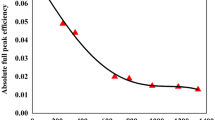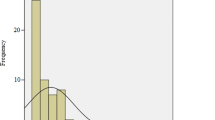Abstract
Natural radioactivity is responsible for most of the total radiation dose received by human population. Geological materials used in building industry usually become contaminated with naturally occurring radioactive materials. They are used as mixtures in building industry (kaolin, zircon, frit, feldspar) or mechanically processed and used for covering floors and walls of the rooms (granite). In this paper, activity concentrations of 226Ra, 232Th and 40K in 6 kaolin, 11 zircon, 18 granite, 3 marble, 6 sand, 4 perlite, 4 feldspar, 5 korund and 1 frit samples imported in Serbia were determined by gamma-ray spectrometry. Activity concentration index, dose rate and annual effective dose were calculated for each of the investigated samples. Measurement of an external gamma dose rate by using a commonly available radiation survey meter can give some indication of the need for further investigations. The absorbed dose rate and annual effective doses for workers in the ceramic industry “Keramika Kanjiza Plus” in Serbia working with granite are determined.









Similar content being viewed by others
References
Ademola JA, Ayeni AA (2010) Measurement of natural radionuclides and dose assessment of granites from Ondo State Nigeria. Radioprotection 45(4):513–521
Al-Haydari A (2011) Determination of specific activity of 226Ra, 232Th and 40K for assessment of environmental hazards of radiation from building rock samples used in Yemen. Radiat Prot Dosim 1–8. doi:10.1093/rpd/ncr031
Alnour IA (2012) Concentrations of 214Pb, 214Bi in 238U Series and 208Tl, 228Ac in 232Th Series in Granite Rock in (Kadugli) Sudan. Indian J Pure Appl Phys 50:285–288
Bikit I, Slivka J, Mrdja D, Zikic-Todorovic N, Curcic S, Varga E, Veskovic M, Conkic LJ (2003) Simple method for depleted uranium determination. Jpn J Appl Phys 42:5269–5273
Bikit I et al. (2006) Study of Active Shielding for Gamma Spectrometers. FINUSTAR. In Harissopulos SV et al. (ed) AIP Conference Proceedings 831, AIP, Melville, NY, 409–411
Bruzzi L, Baroni M, Mazzotti G, Mele R, Righi S (2000) Radioactivity in raw materials and end products in the Italian ceramics industry. J Environ Radioact 47:171–181
Carter CB, Norton MG (2007) Ceramic materials, science and engineering. Springer, Science + Business Media, LLC
Cevik U et al (2009) Assessment of natural radioactivity of sand used in Turkey. J Radiol Prot 29:61–74
Cooper M (2005) Naturally occurring radioactive materials (NORM) in Australian industries—review of current inventories and future generation, Enviro Rad Services Pty.Ltd. ERS-006
EC (1999, 1999). European Commission. Radiation protection unit, radiological protection principles concerning the natural radioactivity of building materials. Radiat Prot 112
Joshua et al (2009) Natural radionuclides and hazards of rock samples collected from Southeastern Nigeria. Radiat Meas 44:401–404
Krstic D, Nikezic D, Stevanovic N, Vucic D (2007) Radioactivity of some domestic and imported building materials from South Eastern Europe. Radiat Meas 42:1731–1736
Llope WJ (2011) Activity concentrations and dose rates from decorative granite countertops. J Environ Radioact 102:620–629
Markkanen Mika (1995) Radiation dose assessments for materials with elevated natural radioactivity. Finnish Centre for Radiation and Nuclear Safety STUK-B-STO 32, Helsinki
Moens L et al (1981) Calculation of the absolute peak efficiency of gamma-ray detectors for different counting geometries. Nucl Instr Methods 187:451–472
Mokobia CE (2011) Determination of the radiological health indexes of using natural kaolin. Scientia Afr 10(1):1–20
Najam LA et al (2013) Measurement of natural radioactivity in building materials used in IRAQ. Aust J Basic Appl Sci 7(1):56–66
Official Gazette of Serbia 36/2009. Law on protection against ionizing radiation and nuclear safety of Serbia (in Serbian)
Official Gazette of Serbia 44/2011. Regulations on the radioactivity control of export, import and transit of the goods (in Serbian)
Official Gazette of Serbia 86/2011. Regulation on limits of radionuclide content in drinking water, foodstuffs, feeding stuffs, drugs, items of general use, building materials and other goods to be placed on the market (in Serbian)
Rehspringer J-L, Balencia J, Vilminot S, Burger D, Boos A, Estournes C (2007) Confining caesium in expanded natural Perlite. J Eur Ceram Soc 27:619–622
Todorovic N et al (2013), Radioactivity in the indoor building environment in Serbia. Radiat Prot Dosim: 1–8 doi:10.1093/rpd/nct210
Todorovic N, Forkapic S, Bikit I, Mrdja D, Veskovic M, Todorovic S (2011) Monitoring for exposures to TENORM Sources in Vojvodina region. Radiat Prot Dosim 144(1–4):655–658
Turhan S (2009) Radiological impacts of the usability of clay and kaolin as raw material in manufacturing of structural building materials in Turkey. J Radiol Prot 29:75–83
UNSCEAR (2000) Sources and effects of ionizing radiation. United Nations Scientific Committee on the effects of Atomic radiation. Exposures from Natural Radiation Sources, Annex B. United Nations, New York
Walley El-Dine N (2001) Measurement of radioactivity and radon exhalation rate in different kinds of marbles and grainites. Appl Radiat Isot 55:853–860
Walley El-Dine N, Sroor A, El-Shershaby A, El-Bahi SM, Ahmed F (2004) Radioactivity in local and imported kaolin types used in Egypt. Appl Radiat Isot 60:105–109
Walley El-Dine N et al (2011) Natural radioactivity and rare earth elements in feldspar samples, Central Eastern desert Egypt. Appl Radiat Isot 69(5):803–807
Zhang G, Qin G, Gao H, Shao C (2011) Al2O3-Reinforced feldspar ceramic composite material. Adv Mater Res 177:390–393
Acknowledgments
The authors acknowledge the financial support of the Ministry of Education, Science and Technological Development of Serbia, within the projects Nuclear Methods Investigations of Rare Processes and Cosmic No. 171002, Biosensing Technologies and Global System for Continues Research and Integrated Management No. 43002 and Studying climate change and its influence in the environment: impacts, adaptation and mitigation No. 43007.
Author information
Authors and Affiliations
Corresponding author
Rights and permissions
About this article
Cite this article
Todorovic, N., Bikit, I., Krmar, M. et al. Natural radioactivity in raw materials used in building industry in Serbia. Int. J. Environ. Sci. Technol. 12, 705–716 (2015). https://doi.org/10.1007/s13762-013-0470-2
Received:
Revised:
Accepted:
Published:
Issue Date:
DOI: https://doi.org/10.1007/s13762-013-0470-2




